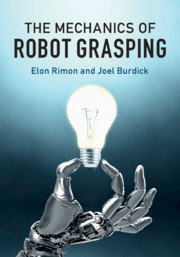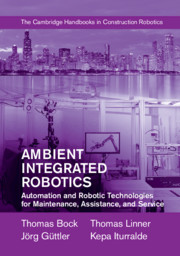Refine search
Actions for selected content:
2002 results in Engineering design, kinematics, and robotics
Index
-
- Book:
- The Mechanics of Robot Grasping
- Published online:
- 03 October 2019
- Print publication:
- 24 October 2019, pp 493-498
-
- Chapter
- Export citation
11 - Frictionless Hand-Supported Stances under Gravity
- from Part II - Frictionless Rigid-Body Grasps and Stances
-
- Book:
- The Mechanics of Robot Grasping
- Published online:
- 03 October 2019
- Print publication:
- 24 October 2019, pp 256-298
-
- Chapter
- Export citation
Contents
-
- Book:
- The Mechanics of Robot Grasping
- Published online:
- 03 October 2019
- Print publication:
- 24 October 2019, pp v-x
-
- Chapter
- Export citation
15 - Hand-Supported Stances under Gravity – Part II
- from Part III - Frictional Rigid-Body Grasps and Stances
-
- Book:
- The Mechanics of Robot Grasping
- Published online:
- 03 October 2019
- Print publication:
- 24 October 2019, pp 371-408
-
- Chapter
- Export citation
5 - A Catalog of Equilibrium Grasps
- from Part I - Basic Geometry of the Grasping Process
-
- Book:
- The Mechanics of Robot Grasping
- Published online:
- 03 October 2019
- Print publication:
- 24 October 2019, pp 81-132
-
- Chapter
- Export citation
18 - Hand Mechanism Compliance
- from Part IV - Grasping Mechanisms
-
- Book:
- The Mechanics of Robot Grasping
- Published online:
- 03 October 2019
- Print publication:
- 24 October 2019, pp 454-477
-
- Chapter
- Export citation
17 - Grasp Manipulability
- from Part IV - Grasping Mechanisms
-
- Book:
- The Mechanics of Robot Grasping
- Published online:
- 03 October 2019
- Print publication:
- 24 October 2019, pp 441-453
-
- Chapter
- Export citation
7 - First-Order Immobilizing Grasps
- from Part II - Frictionless Rigid-Body Grasps and Stances
-
- Book:
- The Mechanics of Robot Grasping
- Published online:
- 03 October 2019
- Print publication:
- 24 October 2019, pp 147-166
-
- Chapter
- Export citation
16 - The Kinematics and Mechanics of Grasping Mechanisms
- from Part IV - Grasping Mechanisms
-
- Book:
- The Mechanics of Robot Grasping
- Published online:
- 03 October 2019
- Print publication:
- 24 October 2019, pp 411-440
-
- Chapter
- Export citation
3 - Configuration Space Tangent and Cotangent Vectors
- from Part I - Basic Geometry of the Grasping Process
-
- Book:
- The Mechanics of Robot Grasping
- Published online:
- 03 October 2019
- Print publication:
- 24 October 2019, pp 38-53
-
- Chapter
- Export citation
Part II - Frictionless Rigid-Body Grasps and Stances
-
- Book:
- The Mechanics of Robot Grasping
- Published online:
- 03 October 2019
- Print publication:
- 24 October 2019, pp 133-134
-
- Chapter
- Export citation
Appendix A - Introduction to Non-Smooth Analysis
-
- Book:
- The Mechanics of Robot Grasping
- Published online:
- 03 October 2019
- Print publication:
- 24 October 2019, pp 478-485
-
- Chapter
- Export citation

The Mechanics of Robot Grasping
-
- Published online:
- 03 October 2019
- Print publication:
- 24 October 2019

Ambient Integrated Robotics
- Automation and Robotic Technologies for Maintenance, Assistance, and Service
-
- Published online:
- 09 July 2019
- Print publication:
- 27 June 2019
2 - Basic Knowledge, Strategies, and Procedures
-
- Book:
- Ambient Integrated Robotics
- Published online:
- 09 July 2019
- Print publication:
- 27 June 2019, pp 12-36
-
- Chapter
- Export citation
4 - Existing AAL Products
-
- Book:
- Ambient Integrated Robotics
- Published online:
- 09 July 2019
- Print publication:
- 27 June 2019, pp 74-103
-
- Chapter
- Export citation
Contents
-
- Book:
- Ambient Integrated Robotics
- Published online:
- 09 July 2019
- Print publication:
- 27 June 2019, pp v-vii
-
- Chapter
- Export citation
Acknowledgments
-
- Book:
- Ambient Integrated Robotics
- Published online:
- 09 July 2019
- Print publication:
- 27 June 2019, pp viii-x
-
- Chapter
- Export citation
6 - Future Trends and Developments
-
- Book:
- Ambient Integrated Robotics
- Published online:
- 09 July 2019
- Print publication:
- 27 June 2019, pp 140-147
-
- Chapter
- Export citation
1 - Introduction
-
- Book:
- Ambient Integrated Robotics
- Published online:
- 09 July 2019
- Print publication:
- 27 June 2019, pp 1-11
-
- Chapter
- Export citation
